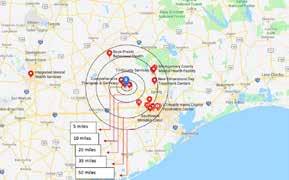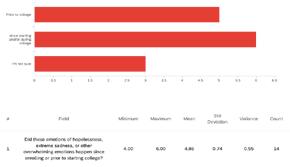
8 minute read
Mental Health of Students of Prairie View A&M University and Discrepancies in the Lack of Awareness and Access to Care
ABSTRACT
Sydney L. Gore 1, 2,3 and Quincy C. Moore, Ph.D. 1,2 1 Department of Biology, Marvin D. and June Samuel Brailsford College of Arts and Sciences, 2 The Honors Program, 3 Undergraduate Medical Academy Prairie View A & M University, Prairie View, TX 77446 RESULTS
Mental illness is a rapidly increasing issue among young adults pursuing higher education. For those attending college at Prairie View A&M University, receiving mental health care is particularly difficult. The current study consists of 80, 18-23-year-old, undergraduate students and examine their self- reported various mental health states and how it can directly relate to a lack of access to care, lack of awareness of mental health topics, or a result of the two. The study, conducted via a quantitative approach, used survey questionnaires via Qualtrics. 67% are female, 30% are male, and 1% are other. Results indicate high rates of mental illness, including depression and anxiety like symptoms, among our sample population. While only 10% have been clinically diagnosed with mental illnesses, 40% of the sample population selfidentified as having one or more mental health problems; these include but are not limited to depression, anxiety, eating disorders and other body disorders, etc. Out of the 40% of the sample population that self-reported having varying forms of emotional detriment, 30% reported it as a direct result of attending college, while 77% generally believe college has negatively impacted them emotionally. 53% have developed adverse behaviors from these negative emotions including but not limited to Of those affected approximately 10% go to the counseling center regularly on campus. Approximately 20% of participants have sought off campus resources, while 15% express the desire. 76% of participants selected that they would like to see more inclusivity, awareness, and mental health treatment options available on the campus with 72% directly answering that they themselves would use them if they existed. In conclusion, the undergraduates have expressed that they do not receive adequate care regarding their mental health issues provided by the institution.
The number of mental health facilities within a 50 mile radius of PVAMU campus
Figure 1: Treatment center count (50 mile radius)


Figure 4: Self Diagnosis of Respondents Figure 2: Treatment center locations (50 mile radius)

Figure 5: Timelines of Self Diagnosis Figure 3: Clinical Diagnosis of Respondents


Figure 6: : Effects of College/ Academics on Self Diagnosis
HYPOTHESIS
The various resources regarding mental health (including treatment) provided by Prairie View A&M University on and both off the Prairie View A&M campus lacks awareness, information, and options for proper treatment when it comes to addressing students well being and the self reported ubiquity of mental illness. METHODS 21 Question Survey was utilized to conduct a qualitative study on college students ages 18-23.
DATA ANALYSIS Via the results of the 21 question survey, results show that there is a lack of awareness, inclusive activities, and treatment and/or service options on the PVAMU campus. Reference research studies show that every 1 in 5 college enrolled student aged 18-25, suffer from a mental illness (Substance Abuse and Mental Health Services Administration) Supported by this research ,91% of total respondents wish to see more mental health services suggesting there is a greater need for mental health awareness. 71 POSTERS AND REPORTS

Figure 7: Effects of College/Academics on Type of Self Diagnosis Figure 8: Respondent Usage of Campus Facilities


Figure 9: Expressed Respondent Need for More Campus Services REFERENCES
Boyraz, G., Horne, S. G., Owens, A. C., Armstrong, A. P., & Boyraz, G. (2016). Depressive symptomatology and college persistence among african american college students.Journal of General Psychology, 143(2), 144- 160. Howard, D. L., Boyd, C. L., Kalsbeek, B., & Godley, P. A. (2010). Developing survey research infrastructure at an historically black College/university to address health disparities.American Journal of Health Studies, 25(3), 149-155. Nealy, M. J. (2007). Addressing the mental health ailments facing black college students.Diverse: Issues in Higher
Education, 24(21), 19. Retrieved from http:// search.ebscohost.com/login.aspx?direct=true&db=t th&AN=27690936&site=ehost-live
Acknowledgements R&I’s Office of Undergraduate Research (OUR) and Biology Department LSAMP,, Prairie View A&M University.
Sydney L. Gore 1,2,3 and Quincy C. Moore 1,2 | 1 Department of Biology, 2 The Honors Program, 3 Undergraduate Medical Academy
Introduction
Mental illness is defined as medical ailments of the brain and its associated structures. It is a condition that may affect one’s thinking, feelings, moods, or perception of reality while impairing the ability of everyday functioning. Mental health issues are medical issues as they do have the ability to constrict a person in the same capacity many physical ailments do. This study aimed to determine the baseline levels of mental illness present within the student population on the Prairie View A&M University (PVAMU) campus. To determine baseline levels of mental illness, this study assessed if undergraduate students feel certain emotions to varying degrees. Reasons for emotions and varying degrees were requested to possibly find a correlation between these issues a student presents with and the availability of offered help and university pressures on student life. The study also explored if health facilities on campus are adequate at treating the number of students who identify as mentally ill and if the students themselves believe the health facilities to be appropriate for their care. The problem that this research studied focused on if the services are adequate, as assessed by the student population, and if any other outside resources are available to the student population; for those attending college at PVAMU, receiving mental health is particularly difficult (Texas Department of State Health Services). This study evaluated the identification of specific mental health issues within the student population, such as varying forms and degrees of depression, feelings of severe despondency and dejection and anxiety, a feeling of worry, nervousness, or unease, typically about an imminent event or something with an uncertain outcome. College stressors are defined as academic stress. (Boyraz, 2016).
Materials and Methods
The study’s design was based on an approved survey IRB Protocol 2019-036. The participants consisted of PVAMU undergraduate students aged 18-23-year-olds. A Qualtrics survey consisting of 16 questions combining both quantitative questions and qualitative questions was used to create the survey and to design, distribute, and analyze all results. Consent was obtained through an information sheet, and all responses in the survey remained completely anonymous. Percentages calculated from the multiplechoice sections were analyzed, and the qualitative questions were pooled and analyzed for common keywords and response factors.
Results and Discussion
Survey results have indicated that there are high rates of mental illness, including depression and anxiety-like symptoms, among our sample population. Demographic information was collected to provide potential links between which student groups of PVAMU feel that there is inadequate care or which student groups are experiencing the discrepancies in the lack and access to mental health care. While these results from the original survey are important, the survey was amended to include more specific information and comprehensive analysis of the undergraduates on campus. The amended version created a more specific self-report of emotions and feelings, giving examples and more inclusive response choices. It also clearly outlined that these feelings may or may not be brought on by the academic setting. In addition to specificity, the amended survey gathered more demographics of the participating population, such as race/ethnicity, classification, and housing status, all of which were not previously included. The study consisted of 67% female, 30% male, and 1% other. Results indicated high rates of mental illness, including depression and anxiety-like symptoms, among our sample population. While only 10% have been clinically diagnosed with mental illnesses, 40% of the sample population self-identified as having one or more mental health problems; these include but are not limited to depression, anxiety, eating disorders and other body disorders, etc. Out of the 40% of the sample population that self-reported having varying forms of emotional detriment, 30% reported it as a direct result of attending college, while 77% generally believe college has negatively impacted them emotionally. 53% have developed adverse behaviors from these negative emotions, including but not limited to excessive crying, anxiety attacks, excessive sleeping, not sleeping, not eating, overeating, etc. Of those affected, approximately 10% utilized the counseling center regularly on campus. Approximately 20% of participants have sought off-campus resources, while 15% expressed the desire. 76% of participants selected that they would like to see more inclusivity, awareness, and mental health treatment options available on the campus, with 72% directly answering that they would use them if they existed.
Conclusion
The results demonstrate a disconnect between the student body and mental health wellness on the PVAMU campus. Further, these results support the theory of health disparities, and that mental health tends to be the branch of medicine that remains unaddressed because of a lack of access to care, community, and consanguineous misunderstandings. These results support the hypothesis that on the PVAMU campus, which is the majority of African American students and other people of color, there are health disparities present.
References
Boyraz, G., Horne, S. G., Owens, A. C., Armstrong, A. P., & Boyraz, G. (2016). Depressive symptomatology and college persistence among African American college students. Journal of General Psychology, 143(2), 144-160. doi:10.1080/00221309.20 16.1163251 Ya Azibo D., Ajanii. (2015). Predicting depression and thinking about suicide on an HBCU campus with depression measures. Western Journal of Black Studies, 39(3), 186-197.
Sydney Gore is a graduating senior majoring in Biology with a minor in Chemistrywith research interests in Ethics and Critical Thinking









